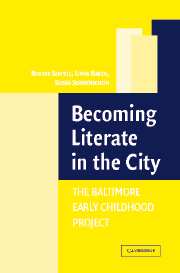Book contents
- Frontmatter
- Contents
- Preface
- 1 Early Appropriation of Literacy in Sociocultural Context
- 2 Growing Up in Baltimore : The Early Childhood Project
- 3 The Intimate Culture of Children's Homes
- 4 Processes of Literacy Enculturation in the Home
- 5 The Development of Literacy Competencies and Orientations
- 6 The Agenda and Practices of Schooling
- 7 Relations Between Homes and Schools
- 8 Conclusions and Implications for Policy and Practice
- References
- Name Index
- Subject Index
Preface
Published online by Cambridge University Press: 17 December 2010
- Frontmatter
- Contents
- Preface
- 1 Early Appropriation of Literacy in Sociocultural Context
- 2 Growing Up in Baltimore : The Early Childhood Project
- 3 The Intimate Culture of Children's Homes
- 4 Processes of Literacy Enculturation in the Home
- 5 The Development of Literacy Competencies and Orientations
- 6 The Agenda and Practices of Schooling
- 7 Relations Between Homes and Schools
- 8 Conclusions and Implications for Policy and Practice
- References
- Name Index
- Subject Index
Summary
Far too many children finish school in contemporary American society without becoming sufficiently literate for successful participation in the economy. The problem is so widely acknowledged in the United States that discussion about its source and solutions is not confined to the halls of academia, but is also widespread in the newspapers, on radio and television, and in state and national legislatures. Although difficulties with academic progress are not limited to children from any particular sociocultural group, the problem is greatest for children from low-income families and children of African and Hispanic heritage.
Our goal when we began planning our study in the early 1990s was to follow a group of children attending public school in a large metropolitan area from prekindergarten through their first few years in elementary school. We were particularly interested in documenting socialization practices in children's home environments. We expected to find different patterns of socialization characteristic of the home environments of children being raised in families from different social addresses. What skills and dispositions did children from different sociocultural groups bring to the task of learning when they entered school? What were the expectations and instructional practices of the teachers in whose classes these children were enrolled? We expected that much of the variance in patterns of school performance would be accounted for by variations in the match between socialization practices experienced by children at home and what was expected of them at school.
- Type
- Chapter
- Information
- Becoming Literate in the CityThe Baltimore Early Childhood Project, pp. vii - xPublisher: Cambridge University PressPrint publication year: 1958

